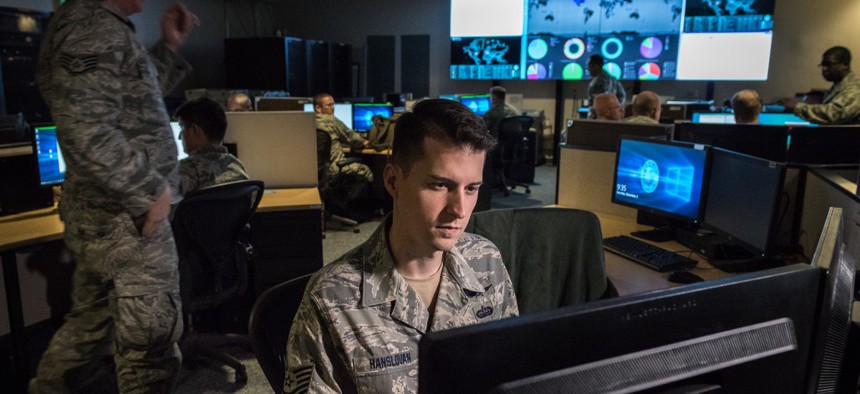DOD’s Digital Threats Are Increasingly Interconnecting, Watchdog Warns

Tech. Sgt. Kyle Hanslovan, a cyber-warfare specialist serving with the 175th Cyberspace Operations Group of the Maryland Air National Guard, works in the Hunter's Den at Warfield Air National Guard Base, Middle River, Md., Dec. 2, 2017. J.M. Eddins Jr./U.S. Air Force
GAO identified six areas that require more oversight, as Defense warfighting operations and national security increasingly hinge on data security.
The new wave of major national security challenges stem from the digital information environment and the continued spread of misinformation and cyber threats across virtual networks, according to a new Government Accountability Office study.
Noting that the U.S. Department of Defense’s warfighting and intelligence operations are largely based on data collection and an interconnected information environment, GAO officials profiled six areas that could benefit from increased data oversight and protection.
The specific six areas of DOD’s digital environment GAO researchers surveyed include: misinformation and disinformation; effects on DOD missions and functions; threat actors; threat actions; institutional challenges; and emerging technologies.
Joseph Kirschbaum, the director of Defense Capabilities and Management at GAO, said that the confluence of these six factors has been increasing over the years and stands to exacerbate threat actions against the DOD.
“The confluence and interaction of cyber, information, electromagnetic spectrum and similar topics is central to an appreciation of the information environment as a whole,” he told Nextgov.
These threat areas can be exploited to undermine DOD missions and operations, particularly through malicious cyber activity against federal networks, illegal data harvesting and attacks on the electromagnetic spectrum that many DOD warfighters rely on.
Impacts of adversarial actions on the DOD’s information environment range from technological fallout to negative impacts on DOD personnel.
One of the burgeoning topics the report highlighted is the targeting of the cognitive foundations of individuals—composed of beliefs, mental health, emotions and experiences—and their key role in the spread of harmful disinformation that can undermine national security.
“The proliferation of ubiquitous information, misinformation, disinformation and malinformation has prompted defense experts to begin examining the concept of cognitive security,” the report notes.
While the concept of cognitive security is not technically new, its application in how military leaders––or anyone––perceive information and the subsequent impact on national security has been given a fresh emphasis. Kirschbaum said that disinformation’s influence plays a “crucial” role in cognitive security.
“It involves a greater recognition of how information coming from so many sources can influence our decisions,” he said.
Additionally, the report notes that emerging technologies, such as artificial intelligence, machine learning, quantum computing and a growing Internet of Things can both help and hinder DOD operations as threats or opportunities.
Kirschbaum clarified that DOD officials are primarily concerned with foreign threat actors from adversarial nations like Russia and China. He also noted, however, that domestic violent extremists employ similar threat tactics.
“DOD must continue to find ways to protect information, systems and minds through disparate security fields, such as information security, operations security, cybersecurity, physical security and cognitive security,” the report writes.






